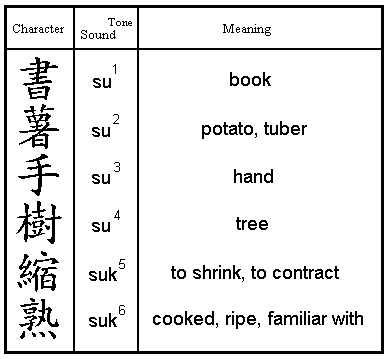

| Tone | Character | Hakka (Traditional Tone Name) | Tone Contours | Examples of Homotonic Characters and their sounds in Sa Tdiu Gok Hakka Click below for sound samples | |
|---|---|---|---|---|---|
| SaTdiuGok (Shatoujiao) | MoiYen (MeiXian) | ||||
| 1 |  | yin pin sang (Upper Level Tone) | /33/ (mid level) | /33/ (mid level) |  ma jiam on sang |
| 2 |  | yong pin sang (Lower Level Tone) | /11/ (low level) | /11/ (low level) |  ma yam van miang |
| 3 |  | song sang (Rising Tone) | /32/ (mid falling) | /31/ (mid falling) |  ba cam pin giang |
| 4 |  | hi sang (Deparating Tone) | /53/ (high falling) | /55/ (high level) |  sa am mun ngang |
| 5 |  | yin ngip sang (Upper Entering Tone) | /3/ (mid staccato) | /31/ (mid falling staccato) |  gap git gok |
| 6 |  | yong ngip sang (Lower Entering Tone) | /5/ (high staccato) | /44/ (mid high staccato) |  hap sit hok |
We can compare them in the following:
| Percieved Tones | /33/ | /11/ | /32/ | /53/ |
|---|---|---|---|---|
| Examples | fun1 to share, divide /33/ |
fun2 tomb, a grave /11/ |
fun3 powder /32/ |
fun4 a share, dividends /53/ |
| fut5 a hole, a depression /3/ |
fut6 Buddha /5/ |
For the majority of Hakka dialects, which belong to the JiaYing subgroup, tone sandhi occurs on the first syllable if the following syllable is of a lower tone for some tones only. For example, if [xn] is a syllable with tone n, the for the Jiaying Hakka subdialect of Shatoujiao:
| Shatoujiao | Traditional Tone Categories | |||||
|---|---|---|---|---|---|---|
| Tone | x1 | x2 | x3 | x4 | x5 | x6 |
| Yin Ping | Yang Ping | Shang | Qu | Yin Ru | Yang Ru | |
| Normal | /33/ | /11/ | /32/ | /53/ | /3/ or /33/ | /5/ or /55/ |
| Sandhi Condition |
[x1] /33/ > /34/ or /35/
[x1] + [x2] |
[x4] /53/ > /55/
[x4] + [x1] |
||||
| ============= | ============= | |||||
| Tones [x1] and [x4] are sandhied when it is followed by a tone which has a lower pitch. | ||||||
© Dylan W.H. Sung 2000.
This page was created on Saturday 29th April 2000,
and was previously updated on Monday 13th November 2000
and recently updated on Tuesday 23 June 2020.